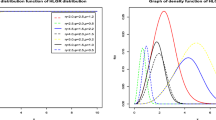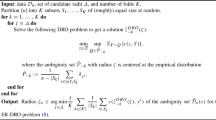Abstract
In this paper, we consider prediction for the exponential distribution with unknown location. For the most part, we treat the one-dimensional case and assume that the location parameter is restricted to an interval. The Bayesian predictive densities with respect to prior densities supported on the real line and the restricted space are compared under the Kullback–Leibler divergence. We first consider the case where the scale parameter is known. We obtain general dominance conditions and also minimaxity and admissibility results. Next, we treat the case of unknown scale. In this case, the location parameter is assumed to be less than a known constant and sufficient conditions for domination are obtained. Finally, we treat a multidimensional problem with known scale where the location parameter is restricted to a convex set. The performance of several Bayesian predictive densities is investigated through simulation. Some of the prediction methods are applied to real data.



Similar content being viewed by others
References
Aitchison J (1975) Goodness of prediction fit. Biometrika 62:547–554
Brown LD, George EI, Xu X (2008) Admissible predictive density estimation. Ann Stat 36:1156–1170
Casella G, Strawderman WE (1981) Estimating a bounded normal mean. Ann Stat 9:870–878
Fourdrinier D, Marchand É, Righi A, Strawderman WE (2011) On improved predictive density estimation with parametric constraints. Electron J Stat 5:172–191
Hamura Y, Kubokawa T (2019) Bayesian predictive distribution for a negative binomial model. Math Methods Stat 28:1–17
Hamura Y, Kubokawa T (2020) Bayesian predictive distribution for a Poisson model with a parametric restriction. Commun Stat Theory Methods 49:3257–3266
Hartigan JA (2004) Uniform priors on convex sets improve risk. Stat Probab Lett 67:285–288
Hudson HM (1978) A natural identity for exponential families with applications in multiparameter estimation. Ann Stat 6:473–484
Juvairiyya RM, Anilkumar P (2018) Estimation of stress-strength reliability for the Pareto distribution based on upper record values. Statistica (Bologna) 78:397–409
Komaki F (2015) Simultaneous prediction for independent Poisson processes with different durations. J Multivar Anal 141:35–48
Kubokawa T (1994) A unified approach to improving equivariant estimators. Ann Stat 22:290–299
Kubokawa T (2005a) Estimation of a mean of a normal distribution with a bounded coefficient of variation. Sankhya 67:499–525
Kubokawa T (2005b) Estimation of bounded location and scale parameters. J Jpn Stat Soc 35:221–249
Kubokawa T, Marchand É, Strawderman WE, Turcotte J-P (2013) Minimaxity in predictive density estimation with parametric constraints. J Multivar Anal 116:382–397
Li M, Sun H, Peng L (2020) Fisher-Rao geometry and Jeffreys prior for Pareto distribution. Commun Stat Theory Methods. https://doi.org/10.1080/03610926.2020.1771593
L’Moudden A, Marchand É, Kortbi O, Strawderman WE (2017) On Predictive density estimation for Gamma models with parametric constraints. J Stat Plan Inference 185:56–68
Marchand É, Perron F (2001) Improving on the MLE of a bounded normal mean. Ann Stat 29:1078–1093
Marchand É, Rancourt F, Strawderman WE (2021) Minimax estimation of a restricted mean for a one-parameter exponential family. J Stat Plan Inference 212:114–125
Parsian A, Sanjari Farsipour N (1997) Estimation of parameters of exponential distribution in the truncated space using asymmetric loss function. Stat Pap 38:423–443
Robert CP (1996) Intrinsic losses. Theor Decis 40:191–214
Singh H, Gupta RD, Nisra N (1993) Estimation of parameters of an exponential distribution when the parameter space is restricted with an application to two-sample problem. Commun Stat Theory Methods 22:461–477
Tripathi YM, Kumar S, Petropoulos C (2014) Estimation of the parameters of an exponential distribution under constrained location. Math Methods Stat 23:66–79
van Eeden C (2006) Restricted parameter space problems—admissibility and minimaxity properties. Lecture notes in statistics, vol 188, Springer, New York
Acknowledgements
We would like to thank the editor, the associate editor, and the three reviewers for many valuable comments and helpful suggestions which improved the paper. Research of the authors was supported in part by Grant-in-Aid for Scientific Research (20J10427, 18K11188) from Japan Society for the Promotion of Science.
Author information
Authors and Affiliations
Corresponding author
Ethics declarations
Conflicts of interest
On behalf of all authors, the corresponding author states that there is no conflict of interest.
Additional information
Publisher's Note
Springer Nature remains neutral with regard to jurisdictional claims in published maps and institutional affiliations.
Yasuyuki Hamura—JSPS Research Fellow.
Appendix
Appendix
Here, we provide Lemmas 3, 4, and 5 and their proofs as well as those of Lemmas 1 and 2.
Lemma 3
Let \(\mu \in \mathbb {R}\) and \({\lambda }\in (0, \infty )\) and let \(h :\mathbb {R} \rightarrow \mathbb {R}\). Suppose that \(\lim _{z \rightarrow \infty } e^{- {\lambda }z} z h(z) = 0\). Then we have
Proof
By integration by parts,
which proves the result. \(\square \)
Lemma 4
Let \(\mu , c \in \mathbb {R}\) and \({\lambda }\in (0, \infty )\) and let \(h :\mathbb {R} \rightarrow [0, \infty )\). Suppose that \(c > \mu \). Then
Proof
We have
which proves Lemma 4. \(\square \)
Part (ii) of the following lemma is used only to establish a strict inequality in the proof of Theorem 7. Although part (ii) is proved below, there will be different proofs.
Lemma 5
Let \(p \in \mathbb {N}\) and let \(D \subsetneqq \mathbb {R} ^p\) be an open convex set containing the origin. Let \({\omega }_2> {\omega }_1 > 0\). Define \({\omega }D = \{ {\omega }\varvec{\xi }| \varvec{\xi }\in D \} \) for \({\omega }\in \{ {\omega }_1 , {\omega }_2 \} \). Then:
-
(i)
\({\omega }_1 D \subset {\omega }_2 D\).
-
(ii)
\(( {\omega }_2 D) \setminus ( {\omega }_1 D)\) has a nonempty interior.
Proof
Part (i) is trivial. We prove part (ii). By assumption, there exists \(\varvec{\xi }_0 \in \mathbb {R} ^p\) such that \(\varvec{\xi }_0 \notin D\). Clearly, \(\varvec{\xi }_0 \ne \varvec{0}\), where \(\varvec{0}\) denotes the origin \(\varvec{0} ^{(p)}\) in \(\mathbb {R} ^p\). Define \(I = \{ t \in [0, \infty ) | \tilde{t} \varvec{\xi }_0 \in D \text {for all} \tilde{t} \in [0, t] \} = \{ t \in [0, \infty ) | t \varvec{\xi }_0 \in D \} \), where the second equality follows from the convexity of D. Let \(t_0 = \sup I \le 1\). Since \(\varvec{0}\) is an interior point of D, we have \(t_0 > 0\). By definition, \([0, t_0 ) \subset I \subset [0, t_0 ]\). Since D is an open set, \(t_0 \notin D\). Thus, \(I = [0, t_0 )\) and \(t_0 \varvec{\xi }_0 \notin D\).
Now, \({\omega }_1 D\) and \({\omega }_2 D\) are open convex sets containing \(\varvec{0}\). Let \(\varvec{\xi }_1 = ( {\omega }_1 t_0 ) \varvec{\xi }_0\) and \(\varvec{\xi }_2 = [ \{ ( {\omega }_1 + {\omega }_2 ) / 2 \} t_0 ] \varvec{\xi }_0\). Since \(\varvec{\xi }_1 \notin {\omega }_1 D\), there exists \(\varvec{0} \ne \varvec{a}\in \mathbb {R} ^p\) such that \(\varvec{a}^{\top } \varvec{\xi }\ge \varvec{a}^{\top } \varvec{\xi }_1\) for all \(\varvec{\xi }\in {\omega }_1 D\). Since \(\varvec{0}\) is an interior point of \({\omega }_1 D\), we have \(\varvec{a}^{\top } \varvec{\xi }< 0\) for some \(\varvec{\xi }\in {\omega }_1 D\). It follows that \(\varvec{a}^{\top } \varvec{\xi }_1 < 0\), that \(\varvec{a}^{\top } \varvec{\xi }_2 < \varvec{a}^{\top } \varvec{\xi }_1\), and that \(\varvec{\xi }_2\) is not a closure point of \({\omega }_1 D\). On the other hand, \(\varvec{\xi }_2 \in {\omega }_2 D\). Therefore, \(\varvec{\xi }_2\) is contained in the intersection of \({\omega }_2 D\) with the complement of the closure of \({\omega }_1 D\). Thus, since the intersection is open, we conclude that \(\varvec{\xi }_2\) is an interior point of \(( {\omega }_2 D) \setminus ( {\omega }_1 D)\). \(\square \)
Proof of Lemma 1
The expressions for \(R( \mu , {\hat{p}}^{( \pi _{{\beta }} )} )\) and for \(R( \mu , {\hat{p}}^{( {\pi _{{\beta }}}^{*} )} )\) for \(\underline{\mu } = - \infty \) are verified by direct calculation. When \(\overline{\mu } = \infty \), we have
from which the desired result follows. \(\square \)
Proof of Lemma 2
By direct calculation, we have that
and that
This completes the proof. \(\square \)
Rights and permissions
About this article
Cite this article
Hamura, Y., Kubokawa, T. Bayesian predictive density estimation with parametric constraints for the exponential distribution with unknown location. Metrika 85, 515–536 (2022). https://doi.org/10.1007/s00184-021-00840-3
Received:
Accepted:
Published:
Issue Date:
DOI: https://doi.org/10.1007/s00184-021-00840-3




